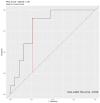Efficacy of magnetic resonance imaging in managing glycogen storage disease
- PMID: 40148892
- PMCID: PMC11948790
- DOI: 10.1186/s13023-025-03605-7
Efficacy of magnetic resonance imaging in managing glycogen storage disease
Abstract
Background: Glycogen storage disease (GSD) is a rare genetic disorder requiring continuous management. It poses a risk of progression to hepatocellular adenoma (HCA) and hepatocellular carcinoma. While ultrasonography is the primary imaging modality to monitor liver health, it has limitations in assessing liver size and detecting HCAs, which can be addressed by magnetic resonance imaging (MRI). This study was conducted to evaluate the efficacy of MRI in the proactive management of GSD and its ability to predict HCA.
Methods: This study included 32 patients with GSD from Wonju Severance Christian Hospital, of whom 29 underwent MRI examinations. Baseline characteristics, such as sex, height, weight, and body surface area (BSA), were recorded, along with laboratory markers. The MRI protocols included T2-weighted axial and coronal imaging, proton magnetic resonance spectroscopy, multi-echo Dixon imaging, magnetic resonance elastography, and T1 mapping. The correlation between liver volumes and laboratory results was analyzed, and logistic regression was used to analyze the association between the liver volume/BSA ratio and adenoma occurrence.
Results: A significant correlation was observed between a high liver volume-to-BSA ratio and the likelihood of HCA development. Receiver operating characteristic curve analysis showed an area under the curve of 0.816 for predicting HCAs and a C-index of 0.847, indicating that MRI had high predictive accuracy. For each unit increase in the liver volume-to-BSA ratio, the probability of HCA increased by 1.005.
Conclusion: MRI is valuable for assessing adenoma formation in patients with GSD. Although not intended for routine surveillance of all patients, MRI can be selectively used in high-risk cases to enable early detection and timely intervention, thereby reducing the risk of progression to malignant transformation.
Keywords: Glycogen storage disease; Hepatocellular adenoma; Liver; Magnetic resonance imaging; Management strategies; Risk prediction.
© 2025. The Author(s).
Conflict of interest statement
Declarations. Ethics approval and consent to participate: This study was approved by the Institutional Review Board of Wonju Severance Christian Hospital (WSCH), Yonsei University Wonju College of Medicine, Wonju, South Korea (approval number: CR321098). Consent for publication: Not applicable. Competing interests: The authors declare that they have no competing interests.
Figures
Similar articles
-
Utility of volumetric contrast-enhanced and diffusion-weighted MRI in differentiating between common primary hypervascular liver tumors.J Magn Reson Imaging. 2018 Oct;48(4):1080-1090. doi: 10.1002/jmri.26032. Epub 2018 Apr 6. J Magn Reson Imaging. 2018. PMID: 29630756
-
Value of Texture Analysis on Gadoxetic Acid-Enhanced MRI for Differentiating Hepatocellular Adenoma From Focal Nodular Hyperplasia.AJR Am J Roentgenol. 2019 Mar;212(3):538-546. doi: 10.2214/AJR.18.20182. Epub 2018 Dec 17. AJR Am J Roentgenol. 2019. PMID: 30557050
-
Characterization of high- and low-risk hepatocellular adenomas by magnetic resonance imaging in an animal model of glycogen storage disease type 1A.Dis Model Mech. 2019 Apr 5;12(4):dmm038026. doi: 10.1242/dmm.038026. Dis Model Mech. 2019. PMID: 30898969 Free PMC article.
-
Hepatocellular adenoma: An unsolved diagnostic enigma.World J Gastroenterol. 2019 May 28;25(20):2442-2449. doi: 10.3748/wjg.v25.i20.2442. World J Gastroenterol. 2019. PMID: 31171888 Free PMC article. Review.
-
Hepatocellular adenoma update: diagnosis, molecular classification, and clinical course.Br J Radiol. 2024 Nov 1;97(1163):1740-1754. doi: 10.1093/bjr/tqae180. Br J Radiol. 2024. PMID: 39235933 Free PMC article. Review.
References
-
- Kishnani PS, Austin SL, Abdenur JE, Arn P, Bali DS, Boney A, et al. Diagnosis and management of glycogen storage disease type I: a practice guideline of the American College of Medical Genetics and Genomics. Genet Med. 2014;16:e1. 10.1038/gim.2014.128. - PubMed
-
- Rake JP, Visser G, Labrune P, Leonard JV, Ullrich K, Smit GPA. Glycogen storage disease type I: diagnosis, management, clinical course and outcome. Results of the European study on glycogen storage disease type I (ESGSD I). Eur J Pediatr. 2002;161(Suppl 1):S20–34. 10.1007/s00431-002-0999-4. - PubMed
MeSH terms
Grants and funding
LinkOut - more resources
Full Text Sources
Medical



